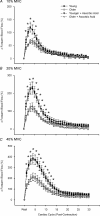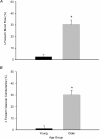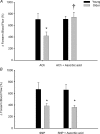Endothelium-dependent vasodilatation and exercise hyperaemia in ageing humans: impact of acute ascorbic acid administration
- PMID: 19307300
- PMCID: PMC2689338
- DOI: 10.1113/jphysiol.2008.167320
Endothelium-dependent vasodilatation and exercise hyperaemia in ageing humans: impact of acute ascorbic acid administration
Abstract
Age-related increases in oxidative stress impair endothelium-dependent vasodilatation in humans, leading to the speculation that endothelial dysfunction contributes to impaired muscle blood flow and vascular control during exercise in older adults. We directly tested this hypothesis in 14 young (22 +/- 1 years) and 14 healthy older men and women (65 +/- 2 years). We measured forearm blood flow (FBF; Doppler ultrasound) and calculated vascular conductance (FVC) responses to single muscle contractions at 10, 20 and 40% maximum voluntary contraction (MVC) before and during ascorbic acid (AA) infusion, and we also determined the effects of AA on muscle blood flow during mild (10% MVC) continuous rhythmic handgrip exercise. For single contractions, the peak rapid hyperaemic responses to all contraction intensities were impaired approximately 45% in the older adults (all P < 0.05), and AA infusion did not impact the responses in either age group. For the rhythmic exercise trial, FBF (approximately 28%) and FVC (approximately 31%) were lower (P = 0.06 and 0.05) in older versus young adults after 5 min of steady-state exercise with saline. Subsequently, AA was infused via brachial artery catheter for 10 min during continued exercise. AA administration did not significantly influence FBF or FVC in young adults (1-3%; P = 0.24-0.59), whereas FBF increased 34 +/- 7% in older adults at end-exercise, and this was due to an increase in FVC (32 +/- 7%; both P < 0.05). This increase in FBF and FVC during exercise in older adults was associated with improvements in vasodilator responses to acetylcholine (ACh; endothelium dependent) but not sodium nitroprusside (SNP; endothelium independent). AA had no effect on ACh or SNP responses in the young. We conclude that acute AA administration does not impact the observed age-related impairment in the rapid hyperaemic response to brief muscle contractions in humans; however, it does significantly increase muscle blood flow during continuous dynamic exercise in older adults, and this is probably due (in part) to an improvement in endothelium-dependent vasodilatation.
Figures






Comment in
-
Keeping the juices flowing with age: vitamin C and exercise hyperaemia.J Physiol. 2009 Jun 1;587(Pt 11):2423. doi: 10.1113/jphysiol.2009.173633. J Physiol. 2009. PMID: 19483250 Free PMC article. No abstract available.
Similar articles
-
Acute ascorbic acid ingestion increases skeletal muscle blood flow and oxygen consumption via local vasodilation during graded handgrip exercise in older adults.Am J Physiol Heart Circ Physiol. 2015 Jul 15;309(2):H360-8. doi: 10.1152/ajpheart.00209.2015. Epub 2015 May 15. Am J Physiol Heart Circ Physiol. 2015. PMID: 25980023 Free PMC article. Clinical Trial.
-
Nitric oxide, but not vasodilating prostaglandins, contributes to the improvement of exercise hyperemia via ascorbic acid in healthy older adults.Am J Physiol Heart Circ Physiol. 2010 Nov;299(5):H1633-41. doi: 10.1152/ajpheart.00614.2010. Epub 2010 Sep 3. Am J Physiol Heart Circ Physiol. 2010. PMID: 20817831 Free PMC article. Clinical Trial.
-
Amplification of endothelium-dependent vasodilatation in contracting human skeletal muscle: role of KIR channels.J Physiol. 2019 Mar;597(5):1321-1335. doi: 10.1113/JP276998. Epub 2018 Dec 26. J Physiol. 2019. PMID: 30506579 Free PMC article. Clinical Trial.
-
Vascular Adaptations to Habitual Exercise in Older Adults: Time for the Sex Talk.Exerc Sport Sci Rev. 2017 Apr;45(2):116-123. doi: 10.1249/JES.0000000000000104. Exerc Sport Sci Rev. 2017. PMID: 28092297 Free PMC article. Review.
-
Vascular effects of exercise: endothelial adaptations beyond active muscle beds.Physiology (Bethesda). 2011 Jun;26(3):132-45. doi: 10.1152/physiol.00052.2010. Physiology (Bethesda). 2011. PMID: 21670160 Free PMC article. Review.
Cited by
-
Systemic vascular function is associated with muscular power in older adults.J Aging Res. 2012;2012:386387. doi: 10.1155/2012/386387. Epub 2012 Aug 26. J Aging Res. 2012. PMID: 22966457 Free PMC article.
-
Mechanisms of rapid vasodilation after a brief contraction in human skeletal muscle.Am J Physiol Heart Circ Physiol. 2013 Jul 1;305(1):H29-40. doi: 10.1152/ajpheart.00298.2013. Epub 2013 May 3. Am J Physiol Heart Circ Physiol. 2013. PMID: 23645465 Free PMC article.
-
Impaired skeletal muscle blood flow control with advancing age in humans: attenuated ATP release and local vasodilation during erythrocyte deoxygenation.Circ Res. 2012 Jul 6;111(2):220-30. doi: 10.1161/CIRCRESAHA.112.269571. Epub 2012 May 29. Circ Res. 2012. PMID: 22647875 Free PMC article.
-
Rho-kinase inhibition improves haemodynamic responses and circulating ATP during hypoxia and moderate intensity handgrip exercise in healthy older adults.J Physiol. 2022 Jul;600(14):3265-3285. doi: 10.1113/JP282730. Epub 2022 May 29. J Physiol. 2022. PMID: 35575293 Free PMC article. Clinical Trial.
-
The paradox of oxidative stress and exercise with advancing age.Exerc Sport Sci Rev. 2011 Apr;39(2):68-76. doi: 10.1097/JES.0b013e31820d7657. Exerc Sport Sci Rev. 2011. PMID: 21206280 Free PMC article.
References
-
- Bailey DM, Lawrenson L, McEnemy J, Young IS, James PE, Jackson SK, Henry RR, Mathieu-Costello O, McCord JM, Richardson RS. Electron paramagnetic spectroscopic evidence of exercise-induced free radical accumulation in human skeletal muscle. Free Rad Res. 2007;41:182–190. - PubMed
-
- Bohm F, Settergren M, Pernow J. Vitamin C blocks vascular dysfunction and release of interleukin-6 induced by endothelin-1 in humans in vivo. Atherosclerosis. 2007;190:408–415. - PubMed
-
- Brock RW, Tschakovsky ME, Shoemaker JK, Halliwill JR, Joyner MJ, Hughson RL. Effects of acetylcholine and nitric oxide on forearm blood flow at rest and after a single contraction. J Appl Physiol. 1998;85:2249–2254. - PubMed
Publication types
MeSH terms
Substances
Grants and funding
LinkOut - more resources
Full Text Sources
Medical

